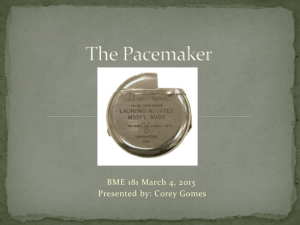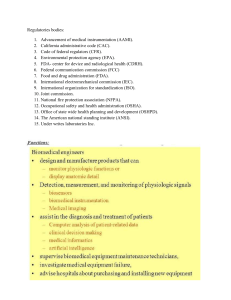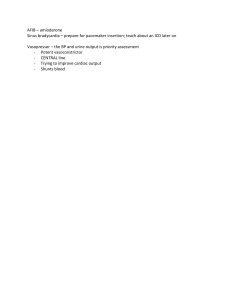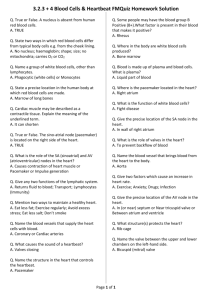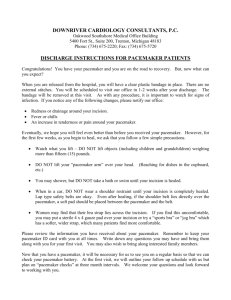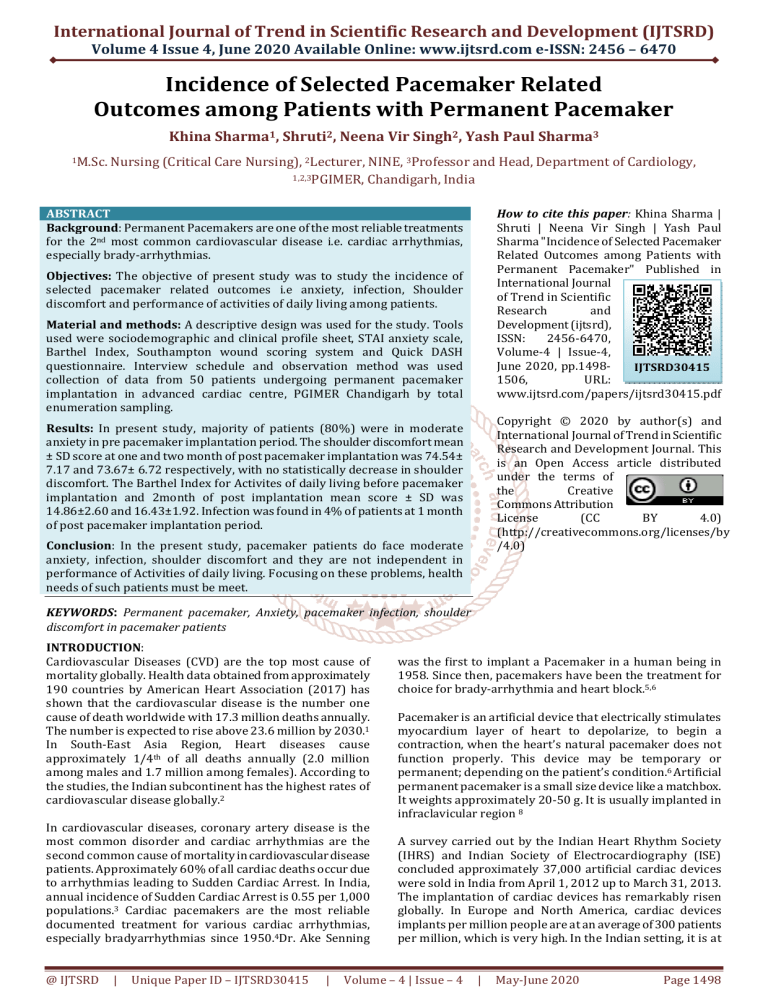
International Journal of Trend in Scientific Research and Development (IJTSRD)
Volume 4 Issue 4, June 2020 Available Online: www.ijtsrd.com e-ISSN: 2456 – 6470
Incidence of Selected Pacemaker Related
Outcomes among Patients with Permanent Pacemaker
Khina Sharma1, Shruti2, Neena Vir Singh2, Yash Paul Sharma3
1M.Sc.
Nursing (Critical Care Nursing), 2Lecturer, NINE, 3Professor and Head, Department of Cardiology,
1,2,3PGIMER, Chandigarh, India
How to cite this paper: Khina Sharma |
Shruti | Neena Vir Singh | Yash Paul
Sharma "Incidence of Selected Pacemaker
Related Outcomes among Patients with
Permanent Pacemaker" Published in
International Journal
of Trend in Scientific
Research
and
Development (ijtsrd),
ISSN:
2456-6470,
Volume-4 | Issue-4,
June 2020, pp.1498IJTSRD30415
1506,
URL:
www.ijtsrd.com/papers/ijtsrd30415.pdf
ABSTRACT
Background: Permanent Pacemakers are one of the most reliable treatments
for the 2nd most common cardiovascular disease i.e. cardiac arrhythmias,
especially brady-arrhythmias.
Objectives: The objective of present study was to study the incidence of
selected pacemaker related outcomes i.e anxiety, infection, Shoulder
discomfort and performance of activities of daily living among patients.
Material and methods: A descriptive design was used for the study. Tools
used were sociodemographic and clinical profile sheet, STAI anxiety scale,
Barthel Index, Southampton wound scoring system and Quick DASH
questionnaire. Interview schedule and observation method was used
collection of data from 50 patients undergoing permanent pacemaker
implantation in advanced cardiac centre, PGIMER Chandigarh by total
enumeration sampling.
Copyright © 2020 by author(s) and
International Journal of Trend in Scientific
Research and Development Journal. This
is an Open Access article distributed
under the terms of
the
Creative
Commons Attribution
License
(CC
BY
4.0)
(http://creativecommons.org/licenses/by
/4.0)
Results: In present study, majority of patients (80%) were in moderate
anxiety in pre pacemaker implantation period. The shoulder discomfort mean
± SD score at one and two month of post pacemaker implantation was 74.54±
7.17 and 73.67± 6.72 respectively, with no statistically decrease in shoulder
discomfort. The Barthel Index for Activites of daily living before pacemaker
implantation and 2month of post implantation mean score ± SD was
14.86±2.60 and 16.43±1.92. Infection was found in 4% of patients at 1 month
of post pacemaker implantation period.
Conclusion: In the present study, pacemaker patients do face moderate
anxiety, infection, shoulder discomfort and they are not independent in
performance of Activities of daily living. Focusing on these problems, health
needs of such patients must be meet.
KEYWORDS: Permanent pacemaker, Anxiety, pacemaker infection, shoulder
discomfort in pacemaker patients
INTRODUCTION:
Cardiovascular Diseases (CVD) are the top most cause of
mortality globally. Health data obtained from approximately
190 countries by American Heart Association (2017) has
shown that the cardiovascular disease is the number one
cause of death worldwide with 17.3 million deaths annually.
The number is expected to rise above 23.6 million by 2030.1
In South-East Asia Region, Heart diseases cause
approximately 1/4th of all deaths annually (2.0 million
among males and 1.7 million among females). According to
the studies, the Indian subcontinent has the highest rates of
cardiovascular disease globally.2
In cardiovascular diseases, coronary artery disease is the
most common disorder and cardiac arrhythmias are the
second common cause of mortality in cardiovascular disease
patients. Approximately 60% of all cardiac deaths occur due
to arrhythmias leading to Sudden Cardiac Arrest. In India,
annual incidence of Sudden Cardiac Arrest is 0.55 per 1,000
populations.3 Cardiac pacemakers are the most reliable
documented treatment for various cardiac arrhythmias,
especially bradyarrhythmias since 1950.4Dr. Ake Senning
@ IJTSRD
|
Unique Paper ID – IJTSRD30415
|
was the first to implant a Pacemaker in a human being in
1958. Since then, pacemakers have been the treatment for
choice for brady-arrhythmia and heart block.5,6
Pacemaker is an artificial device that electrically stimulates
myocardium layer of heart to depolarize, to begin a
contraction, when the heart’s natural pacemaker does not
function properly. This device may be temporary or
permanent; depending on the patient’s condition.6 Artificial
permanent pacemaker is a small size device like a matchbox.
It weights approximately 20-50 g. It is usually implanted in
infraclavicular region 8
A survey carried out by the Indian Heart Rhythm Society
(IHRS) and Indian Society of Electrocardiography (ISE)
concluded approximately 37,000 artificial cardiac devices
were sold in India from April 1, 2012 up to March 31, 2013.
The implantation of cardiac devices has remarkably risen
globally. In Europe and North America, cardiac devices
implants per million people are at an average of 300 patients
per million, which is very high. In the Indian setting, it is at
Volume – 4 | Issue – 4
|
May-June 2020
Page 1498
International Journal of Trend in Scientific Research and Development (IJTSRD) @ www.ijtsrd.com eISSN: 2456-6470
an average of 25 implants/million population.9 Strickland
(2013) stated that, currently more than 3 million patients
worldwide are with implanted permanent pacemaker.10
According to Timby and Smith (2010), pacemakers improve
quality of life and prevent death. Optimal outcome after
permanent pacemaker insertion can only be obtained if
patients are supported in compliance to a lifelong with
permanent pacemaker.11
The implantation of the permanent pacemaker is only the
first step in the lifelong treatment of the patient with a
pacemaker, and long-term follow-up is essential not only for
the safety but is also the key to optimal utilization of the
pacing system. However in most places in India, patients
with implanted pacemakers are usually go for follow up only
once in a year and often only toward the end of pacemaker
battery life.12
According to Ackley & Ladwig (2007), In permanent
pacemaker patients reporting anxiety, the attributed
etiology is fear of dysfunction of the pacemaker and the
feelings of helplessness due to dependence on artificial
pacemaker and changes in lifestyle that the patient will have
to do.13According to Duru et al. (2001); patients with a heart
arrhythmia with a permanent pacemaker perceive it as an
“extension of their life”. However, anxiety of patients was
associated with technical problems and pacemaker battery
depletion.13
Vellone et al (2008) did a descriptive, correlational and
comparative study on Anxiety and depression before and
after a pacemaker implantation in Rome on 154 patients.
They observed that Anxiety and depression in patients
before and after a pacemaker implantation has been under
studied despite an increased use of pacemaker therapy in
the world. It was seen that, Anxiety and depression
significantly decreased from the pre to the post implantation
groups. People less old, less educated, with lower income
and fewer children were more anxious and depressed before
the implantation. 14
Findikoglu et al in 2015 studied Limitation of movement and
shoulder disabilities in 49 patients with permanent
pacemaker. Limitations of motion for abduction, flexion, and
internal rotation were reported to be significantly lower in
the arm on the side of pacemaker compared with the
opposite arm. Significant differences in shoulder abduction,
flexion, and external rotation were reported compared with
long-term recipient (P<0.05). However, the comparison in
function of groups was found not significant. A low to
moderate amount of shoulder disability was found in
patients with cardiac devices (p value <0.05). 15
A survey was carried out by Aqeel et al (2008) about
Pacemaker patients' perception of unsafe activities in
Karachi, Pakistan. A considerable proportion of pacemaker
patients believed many routine activities unsafe including
electrical wall switches (56%), irons (55%), television/video
cassette recorders (53%), bending over (37%), passing
through metal detectors (31%), driving automobiles (28%),
and sleeping on the side of the pacemaker (30%). The
researchers concluded that their patients perceived many
safe routine activities as unsafe, eventually leading to
disabling life style changes.16
@ IJTSRD
|
Unique Paper ID – IJTSRD30415
|
Despite the known benefits of pacemaker devices and the
greater ease in implantation, the incidence of infection is
increasing. Baddour et al earlier reported that there was a
210% increase in artificial cardiac device related infection
from 1993 to 200817. Recent data show that the incidence of
cardiac device-related infection ranged from 0.5%-4.8%.
There has been a steady rise of infection at a rate of 2.5% per
year in 2008 compared to 1.5% per year in 2004.17 More
importantly, about 3% of high risk patients who have cardiac
device implanted can develop cardiac device-related
infection. Infection is associated with morbidity, mortality
and increased cost.18 Additionally, it is estimated that the
average cost to care for someone with cardiac device-related
infection is $54,926.19
Implantation of the pacemaker is a vital event of one’s life.
Pacemaker Implants saves the patient from life threatening
arrhythmias. But the complications of pacemaker
implantation are not uncommon. The complications that may
arise includes pacemaker site infection, bleeding, hematoma,
pneumothorax, hemothorax, ventricular ectopy, tachycardia,
dislocation of the lead, frozen shoulder, shoulder discomfort
etc.20 Along with physical complications, patients who
require pacemaker may also be in fear, anxiety, stress and
even depression due to the feelings of being dependent on an
artificial device, fear of device malfunction, fear of death,
expensive cost of pacemaker and lifelong follow up.
Therefore the present study was conducted to study
incidence of pacemaker related outcomes i.e. anxiety,
infection, shoulder discomfort and performance of ADL
among patients undergoing pacemaker implantation.
Material and Methods:
A Quantitative Research Approach with descriptive study
design was used in the present study. This study was
conducted in Cardiology wards of Advanced Cardiac Centre,
PGIMER, Chandigarh from June –September, 2017. Sample
population included patients undergoing permanent
pacemaker implantation in PGIMER, Chandigarh. Patients
was enrolled at time of admission and regular follow-up was
done till 2month of post pacemaker implantation. The total
sample size was 50. Inclusion Criteria included Patients
undergoing permanent pacemaker implantation in ACC,
PGIMER, Chandigarh and Patients willing to participate in
the study. The variables in this study were anxiety of patient,
pacemaker site infection, shoulder discomfort and Activities
of Daily Living of the patient.
The following tools were used to assess the various
parameters:Patient
identification
data
sheet,
Sociodemographic profile of patient., Personal profile of
patient, Clinical profile of patient , STAI anxiety scale for
assessment of patient’s anxiety, QuickDASH questionnaire
for assessment of shoulder discomfort, Southampton wound
scoring system for pacemaker site assessment and Barthel
Index for assessment of Activities of Daily Living.
STAI i.e. State Trait Anxiety Inventory is an introspective
psychological inventory consisting of trait and state anxiety
affect. State anxiety can be explained as nervousness, fear,
discomfort leading to the arousal of the autonomic nervous
system induced temporarily by current situations perceived
as dangerous whereas Trait anxiety can be explained as a
relatively enduring disposition to feel worry, stress, and
discomfort. Only state scale was used in present study. It
Volume – 4 | Issue – 4
|
May-June 2020
Page 1499
International Journal of Trend in Scientific Research and Development (IJTSRD) @ www.ijtsrd.com eISSN: 2456-6470
comprises 20 items and was scored on 4-point forced-choice
Likert-type response scales. Scores range from 20 to 80. Low
scores suggest mild anxiety; median scores suggest
moderate anxiety, while high scores suggest severe anxiety.
Anxiety was assessed at pre pacemaker implantation period
and at post pacemaker implantation period.
Southampton wound scoring system was used for
assessment of the pacemaker incision site. It comprises total
6 grades, started from grade 0 to grade 6. According to
grades given, Wounds scoring is as:- Normal healing (grade 0
or grade I), Minor complication (grade II or grade III) and
Wound infection (grade IV or V) requires antibiotics or other
treatment.
Barthel Index was used for ADL, which contains total 10
points i. e. feeding, grooming, bathing, toilet use, transfer,
mobility, dressing, stairs, bowel and bladder. Each
performance item was rated on this scale with a given
number of points assigned to each level. A higher number
was associated with a high likelihood of being able to live at
home with a degree of independence. The amount of time
and assistance required to perform each item were used in
determining the assigned number of each item. Total scores
range from 0 – 20, where lower scores depicting increased
disability.
A standard questionnaire was used for assessment of
shoulder discomfort among patients. This questionnaire
depicts patient’s symptoms as well as ability to do certain
activities in the last week. There are total 11items in the
questionnaire like Open a tight or new jar, Do heavy
household chores (e.g., wash walls, floors), Carry shopping
bag/briefcase, Wash back, Use a knife to cut food, Limitation
in work or other regular daily activities as a result of
shoulder problem?, Shoulder pain, Tingling in shoulder and
Difficulty in sleeping because of the pain in shoulder etc.
Each item was scored on 5-point forced-choice Likert-type
response scales. Scores are calculated by formula = [(sum of
n responses/n) – 1] x 25, where n is equal to the number of
completed responses.Thus the maximum score is 100. More
the value means more shoulder discomfort.
Approval of research study was sought from the Institute’s
Ethics Review Committee of PGIMER Chandigarh and
permission was taken from head of cardiology department.
Tools were validated by a team of experts. In order to check
the feasibility of the study, pilot study was done before the
actual data collection period i.e. in May-June, 2017.
Interview technique and Observation method were used for
final data collection. Assessment of outcome variables was
done before pacemaker implantation and after pacemaker
implantation till 2 month of implantation.
Data analysis was done with the help of Statistical Package
for Social Sciences (SPSS version 20). Descriptive statistics
i.e. mean. Percentage, frequency and standard deviation
were used for describing the variables. In inferential
statistics t-test was also used. Data was presented in form of
tables and figures as suitable.
Results
Table 1: shows the Sociodemographic distribution of study subjects. The mean age± SD of the study subjects was 64.32±15.58
with range 16-88 years. Majority of study subjects were male (64%), non-literate (42%), married (70%), Hindu (82%) and
were unemployed (66%). 58% of study subjects were living in villages.
Table 1: Socio-demographic profile of study subjects undergoing permanent pacemaker implantation
N=50
Variable
Study subjects (n1=50) f (%)
Age(in years)*
<40
41-80
>80
Gender
Male
Female
Qualification
Non-literate
Primary school
Middle school
High school
Post high school
Graduate and above
Marital status
Unmarried
Married
Widow/ Widower
Religion
Hindu
Muslim
Sikh
Christian
@ IJTSRD
|
Unique Paper ID – IJTSRD30415
05(10)
38(76)
07(14)
32(64)
18(36)
21(42)
07(14)
06(12)
09(18)
02(04)
05(10)
02(4)
41(82)
7(14)
35(70)
01(02)
13(26)
01(02)
|
Volume – 4 | Issue – 4
|
May-June 2020
Page 1500
International Journal of Trend in Scientific Research and Development (IJTSRD) @ www.ijtsrd.com eISSN: 2456-6470
Type of family
Nuclear family
Joint family
Per capita income (in
Rs)**
<1000
1001-2000
2001-3000
>3000
Habitat
City
Town
Village
Life-style Pattern
Sedentary
Mild worker
Moderate worker
Occupation
Employed
Unemployed
Student
Occupation type
Require mental effort
Require muscular effort
None
26(52)
24(48)
21(42)
06(12)
10(20)
13(26)
10(20)
11(22)
29(58)
26(52)
18(36)
06(12)
14(28)
33(66)
03(06)
05(10)
11(22)
34(78)
Table 2: shows 78% of the study subjects presented with chief complaint of dyspnoea. Clinical diagnosis of 60 % patients was
complete heart block. Sick sinus syndrome and 2nd degree heart block were the other main indications for permanent
pacemaker implantation. Majority of study subjects had Hypertension and Diabetes as comorbidity. Majority of the study
subjects underwent single chamber, MRI compatible, VVIR mode pacemakers.
Table 2: Clinical profile characteristics of study subjects
N=50
Study subjects (n1=50) f (%)
Variable
Chief complaints of patient on admission
Dyspnea
Yes
No
Dizziness
Yes
No
Palpitations
Yes
No
Syncope
Yes
No
Presyncope
Yes
No
Other(chest pain, Giddiness, ghabrahat, fatigue, weakness)
Yes
No
39(78)
11(22)
03(06)
47(94)
04(08)
46(92)
25(50)
25(50)
11(22)
39(78)
20(40)
30(60)
Clinical diagnosis of patient
2nd degree heart block
Complete heart block
Sick Sinus Syndrome
Bundle branch block
Sinus bradycardia
Co-morbidities
Diabetes mellitus
Hypertension
Coronary Artery Disease
Other (DCMP*, CHD**, CVA***)
@ IJTSRD
|
Unique Paper ID – IJTSRD30415
06(12)
30(60)
10(20)
02(04)
02(04)
14(28)
27(54)
05(10)
12(24)
|
Volume – 4 | Issue – 4
|
May-June 2020
Page 1501
International Journal of Trend in Scientific Research and Development (IJTSRD) @ www.ijtsrd.com eISSN: 2456-6470
Temporary pacemaker insertion done before PPI
Done
07(14)
Not done
43(86)
Pulse generator replacement
Yes
05(10)
No
45(90)
Permanent Pacemaker Type
Single chamber
32(64)
Double chamber
16(32)
Biventricular
02(04)
MRI**** compatibility
MRI compatible
34(68)
MRI non-compatible
16(32)
Pacemaker Code:
VVIR*****
26(52)
DDDR******
13(26)
VVI*******
06(12)
DDD********
05(10)
#yate corrected chi-square *DCMP-Dilated cardiomyopathy **CVA-cerebrovascular accident ***CHD-congenital heart diseas
****MRI- Magnetic resonance imaging
*****VVIR: ventricles ventricles inhibitory rate modulation
******DDDR: dual dual dual rate modulation *******VVI: ventricles ventricles inhibitory ********DDD: dual dual dual
Table 3: representing that majority of study subjects were vegetarian, non-alcoholic, non-smoker. 20% participants suffered
from altered sleep pattern during hospitalization. More than half of study subjects were having normal Body Mass Index i.e.
18.5-24.9. The main EMI Equipment used was cell phone (78%).
Table 3: Personal profile of study subjects
Variables
Dietary Habits
Vegetarian
Non- vegetarian
Alcoholic
Yes
Occasional
Left
No
Smoker
Yes
Left
No
Altered bowel function
Prior to hospitalization
Present
Absent
During hospitalization
Present
Absent
After hospitalization
Present
Absent
Body Mass Index
(kg/m2)*
<18.5
18.5-24.9
30- 34.9
35- 39.9
EMI** equipment use
cellphone
welding equipment
No
N=50
Study subjects n1=50 f (%)
28(56)
22(44)
04(08)
01(02)
06(12)
39(78)
03(06)
06(12)
41(82)
02(04)
48(96)
19(38)
31(62)
15(30)
35(70)
04(08)
34(68)
06(12)
06(12)
39(78)
01(02)
10(20)
*BMI = body mass index (mean±SD, range)= 23.82± 03.92, 15-35
@ IJTSRD
|
Unique Paper ID – IJTSRD30415
|
Volume – 4 | Issue – 4
**EMI: electromagnetic interference
|
May-June 2020
Page 1502
International Journal of Trend in Scientific Research and Development (IJTSRD) @ www.ijtsrd.com eISSN: 2456-6470
Table 4: this table represents the Anxiety score by STAI Scale. 80% of patients in pre pacemaker implantation period were
moderate anxious (score 41-60), 18% were mild and 2% were in severe anxiety. While in post pacemaker implantation period
72% were in mild, 28% in moderate and none of the patients were in severe anxiety. The results show that patients posted for
pacemaker implantation exhibits anxiety due to change in health condition and need of artificial device for survival.
Table 4: Assessment of Anxiety of study subjects
Anxiety levels
(score range: 20-80)
Mild Anxiety (score 20-40)
Moderate Anxiety (score 41-60)
Severe Anxiety (score 61-80)
N=50
State anxiety after pacemaker
implantation f(%)
36(72)
14(28)
00
State anxiety before
pacemaker implantation f(%)
9(18)
40(80)
1(2)
Table 5: represents the Barthel Index score of activities of daily living. Baseline Barthel Index value was 14.86±2.60, as
maximum attainable score was 20. The values can be less because of the brady-arrhythmias and associated features like
decrease pulse rate, syncope, fatigue, weakness etc. At 5th post PPI day the score (Mean±SD) was 10.08±2.65 with range 2-16.
With increase in post PPI days, there was increase in Barthel Index score and patient started to perform Daily activities.
Table 5: Assessment of independence in performance of activities of daily living of subjects under study
N=50
Barthel score (max score= 20)
Mean ±SD, Range
Pre Pacemaker implantation score
14.86±2.60, 9-18
Post pacemaker implantation day 5
10.08±2.65, 2-16
Post pacemaker implantation day 10
12.44±1.79, 7-16
Post pacemaker implantation month 1
14.96±2.44, 5-18
Post pacemaker implantation month 2 n1=49 16.43±1.92, 11-18
Table 6: is frequency and percentage distribution of pacemaker implantation site assessment of study subjects on 5th, 10th post
implant days and at 1 and 2 month follow ups, which shows that deep and severe wound was not found in any study subject but
pus at one point of <2cm area was found in 2 patients of at 1 month assessment.
Table 6: Assessment of permanent pacemaker site among study subjects by Southampton Wound Scoring System
N=50
Post PPI
Post PPI
Post PPI
Post PPI day 5
day 10
month 1
month 2
Score (by Southampton Wound Scoring System)
n1=50
n1=50
n1=50
n1=49
f(%)
f(%)
f(%)
f(%)
0: Normal Healing
42(84)
44(88)
46(92)
49(100)
A: Some bruising
02(04)
03(06)
…….
……..
I: Normal healing
with mild bruising or
B:-Considerable bruising
01(02)
……..
……..
……..
erythema
C:- Mild erythema
……..
……..
……..
……..
A:-At one point
01(02)
………
01(02)
……..
II: Erythema and
B:-Around sutures
01(02)
01(02)
01(02)
……..
other signs of
inflammation
C:-Along wound
……..
……..
……..
……..
D:-Around wound
……..
……..
……..
……..
A:At
one
point
only
(<
2
cm)
01(02)
01(02)
01(02)
……..
III: Clear or
B:-Along wound (> 2 cm)
……..
……..
……..
……..
haemoserous
discharge
C:- Large volume
……..
……..
……..
……..
D:-Prolonged (> 3 days)
……..
……..
……..
……..
A:-At one point only (< 2 cm)
…….
……..
02(04)
…….
IV: Pus
B:-Along wound (> 2 cm)
……..
……..
……..
……..
V: Deep or severe wound infection with/without
…….
……..
……..
……..
tissue breakdown; haematoma requiring aspiration
Table 7: represented that the mean QuickDASH score ± SD of shoulder discomfort was 74.54± 7.17 at 1 month of post PPI and
72.67±5.14 at 2month of post PPI. Maximum score was 100. There was no statistically significant difference in shoulder
discomfort at 1 and 2 month follow-up. This shows that patients face shoulder discomfort at site of pacemaker implantation
due to arm immobilization and restriction of shoulder movement.
Table 7: Assessment of shoulder discomfort at 1 month and 2 month of post pacemaker implantation
Quick DASH score (max attainable score 100)
QuickDASH score at 1 month
QuickDASH score at 2month
@ IJTSRD
|
Unique Paper ID – IJTSRD30415
|
mean± SD
74.54± 7.17
73.67±6.72
Mean difference ±SD
N=49
t test (df) p value
0.86± 3.06
1.97 (48) 0.06
Volume – 4 | Issue – 4
|
May-June 2020
Page 1503
International Journal of Trend in Scientific Research and Development (IJTSRD) @ www.ijtsrd.com eISSN: 2456-6470
Discussion
Pacemaker devices are the blessing of technology for
patients with cardiac rhythm abnormality. The survival rate
of patients with brady-arrhythmias is improved a lot after
the arrival of pacemaker technology. It is a small battery
powered device which is usually implanted in infraclavicular
region. It saves life of the patient, but it is not a very
comfortable artificial device for the patient. Patients need to
make mange modifications to ensure safety and adequate
pacemaker function. Although pacemaker implantation is
becoming very common in twenty first century but in
absence of knowledge and poor care the chances of
psychological and physical complications associated with
these devices are also not uncommon.
The purpose of the present study was to see the factors:
anxiety, infection, Shoulder discomfort and performance of
activities of daily living among the pacemaker implantation
patients. Regular follow-up of patients was done till 2
months and the selected outcome variables were assessed
time to time.
In present study, the mean age of study subjects was
63.3±15.78. Similar findings were obtained by Elsalam
(2010), who said that pacemaker are implanted in
individuals of all ages ,but the most in older adults, this is
due to an increase in abnormalities of impulse generation
and conduction with advancing age21. In the study done by
Nagwa (2014) majority of study group patients were
between 61-80 years, this study also supports the current
finding22. Similar results was found by Hanaa (2017) with
mean age ±SD= 65.7±5.7 of pacemaker study subjects23.
In relation to gender, the present results showed that,
majority of study sample were male i.e. 64% from control
group and 60% from experimental group were male. This
finding is in agreement with that of Elsayed (2013) and
Panda (2011) who found that, prevalence of permanent
pacemaker in males was 1.5 times that in female21.
Regarding habitat, this study revealed that majority of
subjects were residing in rural area. This may be due to nonavailability of specialized hospitals affording pacemaker
insertion in rural areas. Similar results were found by
Hussein (2005) and Elsayed (2013) i.e. approximately two
thirds of their studied subjects were residing in rural areas24.
As regards having co-existing diseases the present study
revealed that more than half of sample studied have chronic
diseases i.e. diabetes and hypertension,this result agree with
Nagwa Mohamed (2014) who reported that approx. half of
the pacemaker patients were having hypertension and/or
diabetes22.
In relation to clinical diagnosis of patient more than half of
the patients were diagnoses with complete heart block. This
finding matches with study done by Nagwa Mohamed (2014)
study in which 75% patients who underwent permanent
pacemaker implantation were diagnosed with complete
heart block.22
Present study found that the majority of patients were in
moderate (score 41-80) state anxiety before pacemaker
implantation period because of many factors like being
diagnosed with heart disease, need of artificial device to live,
expenditure of treatment etc. Mild to moderate anxiety in
@ IJTSRD
|
Unique Paper ID – IJTSRD30415
|
post pacemaker implantation period was seen and the major
cause of anxiety were fear of pacemaker malfunctions, its
interference with electronic devices, being dependent on
artificial device, battery end etc. Similar results were found
by the study done by Figueroa et al (2016), study showed
that 81.8% of patients encounter anxiety in the pre-test and
it reduced to 45.5% in the phase of post –evaluation after
interventions.25 Similarly, in a research study, performed at
the Hospital General de Mexico (2011), 27.9% pacemaker
patients experienced moderate to severe anxiety.13
Similar study done by Xin et al on Influence of Continuous
Nursing on the Psychological State and Coping Style of
elderly patients who were undergoing pacemaker
implantation from Harbin City (China). In the study Routine
nursing was applied to the control group; continuous
nursing support was provided for the intervention group
from January 2014 to January 2015. The anxiety level in pre
and post periods of the two groups were compared by using
Zung’s Self - Rating Anxiety Scale. It was seen that in
Intervention group (n = 54) anxiety was reduced from 44.5 ±
9.2 to 35.2 ± 7.8 with continuous nursing as in Control group
(n = 49) it was reduced from 43.9 ± 8.9 to 41.6 ± 7.8 in pre
and post periods with p value <0.001.26
Infection in a permanently implanted Pacemaker is a serious
complication. Pacemaker site infection is one of the major
reasons of readmission into cardiac centres and patient
morbidity after pacemaker implantation.
Past studies has shown that the pacemaker site infection
ranges from 1% to >10%. 27 Baddour et al reported that
there is 210% increase in pacemaker device infection from
1993 to 2004.17 A study done by Johansen1 et al concluded
that infection may occur either as a surgical site infection
(SSI), occurring within 1 year after pacemaker implantation
or as late-onset pacemaker lead endocarditis.28
Present study revealed that 6% patients of control group
developed minor wound complications and 4% developed
wound infection at 1month of post pacemaker implantation.
On comparing the results with study done by Nagwa (2014),
showed that, 3.3% patients of developed wound infection in
the study.22
In the current study it was seen that the independence in
performance of activities of daily living (ADL) like feeding,
bathing, grooming, mobility, transfer, toilet use, stair use etc.
was affected due to cardiac rhythm disorder and limitation
of shoulder movement due to pacemaker implantation and
after artificial device implantation ADL were improved with
increase in post Pacemaker implantation days. No previous
study till date is done to see the performance of activities of
daily living in patients with pacemaker implantation devices.
Previous studies have shown that due to restriction of
affected shoulder movement (due to risk of lead
displacement) chances of shoulder discomfort are there. In
the present study, QuickDASH Questionnaire (maximum
attainable score-100) was used to measure the shoulder
discomfort. The shoulder discomfort score was (mean ±SD)
74.54±7.17 (at 1 month of P/PPI) and 73.67±6.72 (at 2
month of P/PPI). There was no statistically significant
decrease in shoulder discomfort with p value <0.05 with one
month time. This shows that specific interventions like
Volume – 4 | Issue – 4
|
May-June 2020
Page 1504
International Journal of Trend in Scientific Research and Development (IJTSRD) @ www.ijtsrd.com eISSN: 2456-6470
shoulder exercises are required to limit shoulder discomfort
and improve ADL. Study done by James et al (2011) supports
the results of present study. In the study done by James et al
(2011), control group received routine instructions as in the
exercise group, during the 1-week post implant visit,
patients were instructed on a series of exercises to be
completed 3 days per week for 6 weeks. Study results
showed a statistically significant improvement in shoulder
discomfort with p value <0.03 among study subjects after
shoulder excercises.29
Findikoglu et al (2015) studied Limitation of movement and
shoulder disabilities in 49 patients with permanent
pacemaker. Shoulder Range of Motion was measured using a
digital goniometer. The opposite arm was used as the
control. Limitations of Range of Motion for abduction,
flexion, and internal rotation were found to be significantly
lower in the arm on the side of pacemaker compared with
the opposite arm. Significant differences in shoulder
abduction, flexion, and external rotation were found
compared with long-term recipient (p value <0.05).
However, the functional comparison of groups was not
significant. A low to moderate shoulder disability was found
in patients with permanent pacemaker (P value <0.05). 15
Therefore present study reveals that permanent pacemaker
implantation causes disturbance in life of patient as
adjustment with artificial device need time, skill as well as
knowledge. It may cause psychological as well as
physiological problems like anxiety, infection, shoulder
discomfort, dependence for ADL etc. Thus a systematic
teaching and practices based information about permanent
pacemaker care can be taught to patients and family to
reduce the chances of occurrence of the complications and
allow the patients to adapt more easily to the pacemaker
devices.
Conclusion:
From the results of the present study, it can be conducted
that:
Patients with permanent pacemakers exhibits moderate
anxiety before as well as after pacemaker implantation.
Infection can occur at pacemaker implantation site.
Therefore care must be taken to prevent pacemaker site
infection.
Patient experiences shoulder discomfort due to
restriction of shoulder movement in post pacemaker
implantation period.
There is decrease in ADL by pacemaker patients.
Performance of tasks of Activities of daily living
increases with increase in post pacemaker implantation
days.
Recommendations:
Pacemaker care guidelines can be prepared and taught
to patents by means of educational aids like simple
booklets, mobile applications, audio assisted and video
assisted methods for better understanding of the
patients with permanent pacemaker.
Longitudinal studies can be conducted for the long term
follow up of pacemaker patients.
Special pacemaker nurses can be trained and appointed
in Cardiac Centres with the objective of teaching the
patient about pacemaker and to improve their skills of
pacemaker care.
@ IJTSRD
|
Unique Paper ID – IJTSRD30415
|
Informational booklets of pacemaker care can be make
available in cardiac department and pacemaker clinics
for pacemaker patients
References
[1] Emelia J, Michael J, Stephanie E, Mary C, Sandeep R,
Rajat D et al. Heart Disease and Stroke Statistics–2017
Update: A Report from the American Heart Association.
Circulation. [Internet]. 2017 [Cited 2018 March 16];
18(2):
209-209.
Available
from:
http://news.heart.org/american-heart-associationstatistical-report-tracks-global-figures-first-time/
[2] Gulland A. Most countries will fail to meet targets on
non-communicable diseases, says WHO. BMJ, 2015;
331-332.
[3] Gaziano T. Cardiovascular Disease in the Developing
World and Its Cost-Effective Management. Circulation.
2005; 112(23): 3547-53.
[4] Nettina M S. Manual of Nursing Practice. 10th ed.
Wolters Kluwer / Lippincott Williams & Wilkins.
London; 2010.
[5] Cardiac arrhythmia - Conditions - GTR - NCBI.
[Internet]. 2018 [Cited on 02 Feb. 2018]. Available at:
https://www.ncbi.nlm.nih.gov/gtr/conditions/C00038
11/
[6] Permanent Pacemaker Insertion: Background,
Indications, Contraindications. [Internet]. 2017 [Cited
21 Oct. 2017]. Available at: https://emedicine.
medscape.com/ article/1839735-overview
[7] Lewis S L, Heitkemper M M, Dirksen S R, Bucher L.
Medical Surgical Nursing; Assessment and
management of client problems. 9th ed. Mosby
Company; 2010.
[8] American Heart Association - Building healthier lives,
free of cardiovascular diseases and stroke. [Internet].
2018 [Cited 15 March. 2018]. Available at:
https://www.heart. org/HEARTORG
[9] Shenthar J P, Jetley V, Bohra S, Vora A, Lokhandwala Y,
Nabar A et al. A survey of cardiac implantable
electronic device implantation in India: By Indian
Society of Electrocardiology and Indian Heart Rhythm
Society. Indian Heart Journal.2016; 65(1):68-711
[10] Levine P. Response to “Rate-adaptive Cardiac Pacing”
Implications of Environmental Noise During
Craniotomy [Internet]. 2018 [cited 10 March 2017].
Available
from:
http://anesthesiology.pubs.asahq.org/Article.aspx?arti
cleid=1948237
[11] Timby B K, Smith N E. Introductory Medical- Surgical
Nursing: Lippincott Williams &Wilkins: New York:
2009: 567- 572.
[12] Rajgopal S, Kapoor A, Bajaj R, Vora A, Sethi K, Sinha N
et al. CSI/IHRS practice guidelines on follow-up of
patients with permanent pacemakers. Indian Heart
Journal. 2012;64:S12-S17.
[13] Figueroa C, Alcocer L, Ramos B.Psychological
Intervention to Modify Anxiety, Depression and Quality
of Life in Patients with an Implantable
Pacemaker. Psychology. 2016 ;7; 374-81.
[14] Vellone E, Galletti C, Morchio A, Rosaria R, Alvaro,
Sansoni J. Anxiety and depression before and after a
Volume – 4 | Issue – 4
|
May-June 2020
Page 1505
International Journal of Trend in Scientific Research and Development (IJTSRD) @ www.ijtsrd.com eISSN: 2456-6470
pacemaker implantation: A comparative study.
International Nursing Perspectives. 2008; 8(3):93-99.
http://drepository.asu.edu.eg/xmlui/bitstream/handl
e/1234567/143264/% D8%B52399.pdf?sequence=1
[15] Findikoglu G, Yildiz B S, Sanlialp M, Alihanoglu Y I, Kilic
I D, Evregul H et al. Limitation of motion and shoulder
disabilities in patients with cardiac implantable
electronic devices. Int J Rehabil Res. 2015;38(4):28793.
[22] Bernstein A, Daubert J, Fletcher R, Hayes D, Luderitz B,
Reynolds D et al. The Revised NASPE/BPEG Generic
Code for Antibradycardia, Adaptive-Rate, and Multisite
Pacing. Pacing and Clinical Electrophysiology.
2002;25(2):260-264.
[16] Aqeel M, Shafquat A, Salahuddin N. Pacemaker
patients' perception of unsafe activities: a survey. BMC
Cardiovasc Disord. 2008; 8: 31.
[23] Hanaa, Yossif A, Ebtisam, Abd El-aal M. Home Care for
Patients with Permanent Pacemaker Insertion. Journal
of Nursing and Health Science. 2017;6(4); 49-57.
[17] Baddour L M, Epstein A E, Erickson C C. Update on
cardiovascular implantable electronic device infections
and their management: A scientific statement from the
American Heart Association. Circulation. 2010; 121:
458-77.
[24] Hussein H. Effect of rehabilitation program for patients
with acute myocardial infarction. Doctorate Thesis in
Medical Surgical Department. Ain Shams University.
2009; 96-102.
[18] McNulty T, Warren J. Antibacterial envelope reduces
cardiac device infection rates at 12 months. Heart
Rhythm Society. [Internet]. 2015 [cited 2017 Aug,13]:
Available
from:
http://newsroom.medtronic.com/phoenix.z
[19] Shariff N, Eby E, Adelstein E. Health and economic
outcomes associated with use of an antimicrobial
envelope as a standard of care for cardiac implantable
electronic
device
implantation.
Journal
of
Cardiovascular Electrophysiology. 2015; 26: 783-789.
[20] Auras R, Atreya, James R. Cook & Lindenauer P.
Complications arising from cardiac implantable
electrophysiological devices: review of epidemiology,
pathogenesis and prevention for the clinician.
Postgraduate Medicine. 2016;128(2); 75-9
[21]
Elsalam A, Shafy A, Rahim A. Effect of an educational
program on the performance of nurses working with
cardiac patients. [Internet]. 2010 [Cited 2017,Oct.06]
available
at:
@ IJTSRD
|
Unique Paper ID – IJTSRD30415
|
[25] Elsayed R. Factor effecting compliance of patients with
permanent pacemaker regarding therapeutic regimen.
[Internet]. 2013 [Cited 2017, Oct.06] available at:
https://www.ncbi.nlm.nih.gov/pubmed/28479089.
[26] Xin L, Xu H , Ling L, Lili H and Zhaojun L. Influence of
Continuous Nursing on the Psychological State and
Coping Style of Patients Undergoing Pacemaker
Implantation. Iran J Public Health. 2015; 44(7); 953-61.
[27] Stevenson R, Lugg D, Gray R, Hollis D, Stoner M,
Williams J. Pacemaker implantation in the extreme
elderly.
Journal
of
Interventional
Cardiac
Electrophysiology. 2011;33(1):51-58.
[28] Johansen J B, Jørgensen O D, Møller M, Arnsbo
P, Mortensen P T, Nielsen J C. Infection after pacemaker
implantation. Eur Heart J. 2011;32(8):991-8.
[29] James D, Daniels, Sun S, Zafereo J, Minhajuddin A,
Nguyen C et al. Preventing Shoulder Pain After Cardiac
Rhythm Management Device Implantation. Pacing Clin
Electrophysiol. 2011; 34(6):672-678.
Volume – 4 | Issue – 4
|
May-June 2020
Page 1506

